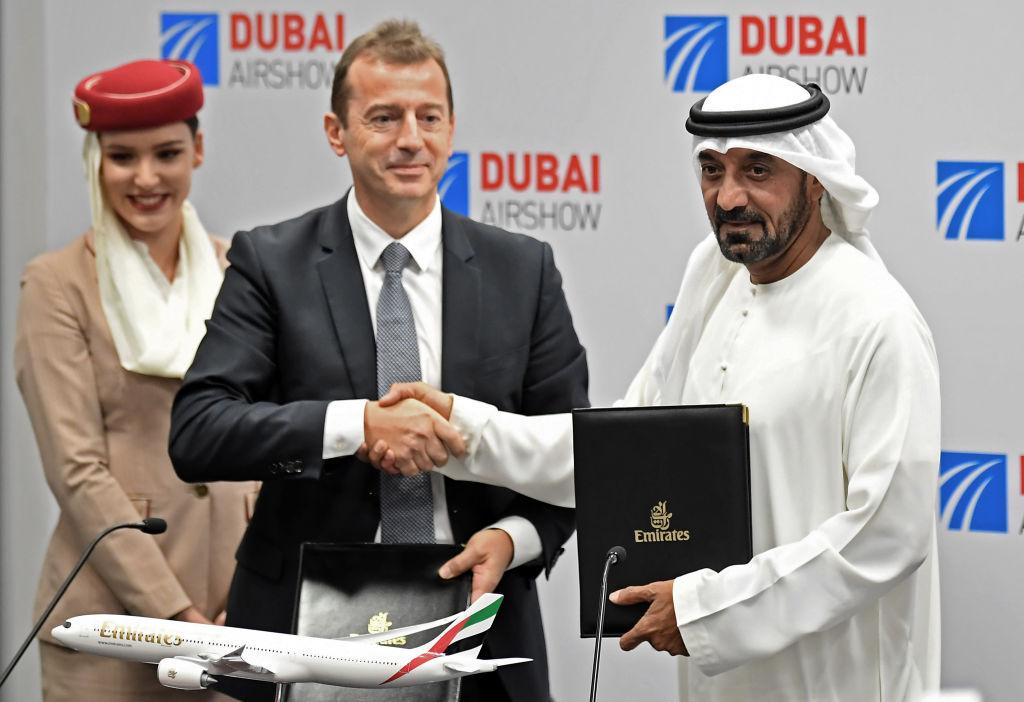Major Gulf Carriers Have Changed Significantly Since Last Dubai Airshow

For a snapshot of how the air transport industry has changed since the end of 2019, look no further than the changed fortunes of the “big three” Gulf carriers.
At Dubai Airshows in previous years, Dubai-based Emirates, Abu-Dhabi-based Etihad Airways and Doha-based Qatar Airways have dominated the stage with multiple huge orders for aircraft announced with great fanfare at press conferences that ricocheted between the Airbus and Boeing chalets.
From a commercial airline perspective, Dubai Airshow 2021 will be a subdued affair compared to those days. “Please, buy a plane or two while you’re out there,” an executive at one of the major OEMs joked with this editor on arrival in Dubai.
The pandemic and related government travel restrictions have been—and continue to be—especially brutal on the long-haul international traffic that is essential to the global hub business models of the major Gulf carriers.
Emirates, once king of that model with its massive fleet of Airbus and Boeing widebodies, saw the business shredded as borders closed. Its fleet of more than 100 Airbus A380s went from asset to financial liability overnight; flying the four-engined superjumbo almost empty of passengers is not sustainable, even in the short term. The airline has lost billions—AED14.1 billion ($3.8 billion) in its 2020-21 fiscal first-half (H1) results alone. While that was reduced to an AED5.7 billion loss in H1 of fiscal 2021-22, announced this past week, chairman and CEO Ahmed bin Saeed Al Maktoum acknowledged there was “still some time to go before we restore our operations to pre-pandemic levels and return to profitability.”
At Etihad, the pandemic exacerbated a financial crisis that the carrier was already fighting to survive because of a previous strategy of investing heavily in partner airlines that subsequently failed, most notably and disastrously in airberlin and Alitalia.
At the Arab Air Carriers’ Association (AACO) AGM in Doha days before the Dubai Airshow, Etihad CEO Tony Douglas said Etihad’s partnership strategy was a mistake.
Speaking on a CEO panel, Douglas said of the then-young Etihad: “People are well aware that we followed a strategy in our teenage years of a quasi-alliance and teenagers make mistakes, and it was a mistake. So we started in 2017 with radical heart surgery and it was a fight for survival. At the end of 2019 we were about nine months ahead of plan and then the pandemic upended everything, so we accelerated the plan and now we have a two-horse strategy based on two incredible machines: the 787 and A350.”
For Qatar Airways, the story has been different again. The airline has not avoided financial losses or cutbacks, but it switched rapidly to expanded cargo operations, which helped mitigate losses, and placed an emphasis on maintaining as much of its network as possible.
Speaking on the same AACO CEO panel, Qatar Airways group president Akbar Al Baker said: “There was a moment in the pandemic when Qatar Airways was the largest airline in the world. All airlines took the strategic decision to stop flying and ground their airplanes. At Qatar, the strategic decision was to keep operating with a similar fleet.
“We said at the time there were opportunities and we were not just going to be a bigger airline, but we also opened new routes.”
At Emirates, too, there are signs of forward movement. The airline took delivery of two new A380s, replacements for two older aircraft that were retired, and it has launched service to Miami—a new destination and one that has surged since the U.S. government reopened its borders to vaccinated air travelers on Nov. 8.
By Sept. 30, Emirates was operating passenger and cargo services to 139 airports, utilizing its entire 777 fleet and A380 fleet.
But will the “big three” be announcing multi-billion-dollar orders in Dubai this week? Airbus and Boeing know all too well the answer.
